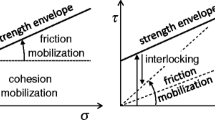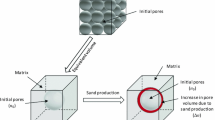Abstract
The mechanical strength of rock in terms of shear or compressive failure has been previously adopted as a criterion for sand production and when used solely has been proven to overestimate the process. On the other hand, ignoring the mechanical strength behaviour of the material increases the tendency for inaccurate estimations of the erosion process. In this work, an equally proportionated inclusion of the mechanical strength and erosion-based criteria in sanding predictions is proposed and assessed by numerical models. Several rock failure models and their influences on the sanding process have been analysed, including models such as the Drucker–Prager (DP), the Drucker–Prager hardening (DP hardening), the Mohr–Coulomb (MC) and the Mohr–Coulomb softening (MC softening). Modelling outcomes show distinct differences in rock response to operating and boundary conditions (e.g. flow rate and drawdown), and predictions of sand production. It was confirmed by modelling results that despite the low magnitude of stresses and strains developed at the well face and perforation regions, post-yield hardening behaviour increases the estimation of the amount and intensity of sand production. Also, incorporating a post-yield softening behaviour increases the magnitude of stresses and strains; however, this effect is observed to have a negligible impact on sand production. The role of void ratio has been recognised as a dominant factor, as its evolution significantly determines the pattern and intensity of sand production. A more cautious selection and rigorous coupling of rock strength models in sand production modelling is therefore essential if accuracy of predictions is to be improved.


















































Similar content being viewed by others
Abbreviations
- \(\tau\) :
-
Shear stress (N/m2 or Pa)
- \(C\) :
-
Coefficient of internal cohesion (N/m2 or Pa)
- \(\bar{C}\) :
-
Mobilised or variable cohesion
- \(C_{0}^{\text{y}}\) :
-
Initial cohesion yield stress
- \(\Upphi\) :
-
Frictional angle or slope
- \(\bar{\Upphi }\) :
-
Mobilised friction angle
- \(\Upphi_{\text{L}}\) :
-
Limit friction angle
- \(\Upphi_{\text{cv}}\) :
-
Friction angle of constant volume
- \(\theta\) :
-
Deviator polar angle
- \(\varphi\) :
-
Dilation angle
- \(\bar{\varphi }\) :
-
Mobilised dilation angle
- \(\sigma\) :
-
Normal stress
- \(\sigma_{1}\) :
-
Major principal stress
- \(\sigma_{2}\) :
-
Intermediate principal stress
- \(\sigma_{3}\) :
-
Minor principal stress
- \(\sigma_{\text{m}}\) :
-
Mean principal stress
- \(\sigma_{\theta }\) :
-
Tangential stress
- \(\tau_{ \max }\) :
-
Maximum shear stress
- q :
-
Equivalent or von Mises stress
- \(\hat{\sigma }\) :
-
Mean stress or equivalent pressure stress (\(\hat{\sigma } \approx \sigma_{\text{m}}\))
- \(I_{1}\) :
-
First stress invariant of the stress tensor
- \(J_{2}\) :
-
Second invariant of the deviatoric stress tensor
- \(J_{3}\) :
-
Third invariant of the deviatoric stress tensor
- g :
-
An invariant related to the third deviatoric stress invariant \(J_{3}\)
- \(S_{ij} S_{jk} S_{ki}\) :
-
Components of the deviatoric stress tensor
- \(\delta_{ij}\) :
-
Kronecker delta
- \(e^{ - p}\) :
-
Effective strain (hardening parameter)
- \(e_{e}^{f}\) :
-
Effective strain at the limit friction angle
- \(e_{e}^{c}\) :
-
Effective strain at zero cohesion
- \(\check{e}_{\text{m}}\) :
-
Meridional eccentricity
- \(H_{n}\) :
-
Parameter that is a function of \(e_{m}\) and \(\theta\)
- \(e_{\text{d}}\) :
-
Deviatoric eccentricity
- K :
-
Ratio of yield stress in triaxial tension to yield stress in triaxial compression
- \(\sigma_{\text{c}}\) :
-
Uniaxial compressive yield stress
- \(\dot{m}\) :
-
Rate of solid mass eroded
- \(\rho_{\text{s}}\) :
-
Solids or particle density
- \(\rho_{\text{d}}\) :
-
Dry density
- λ:
-
Sand production coefficient
- \(\vartheta\) :
-
Porosity
- c :
-
Concentration of fluidised solids transported
- \(q_{i}\) :
-
Fluid flux
- \(v_{\text{e}}\) :
-
Erosion velocity
- \(v_{w}\) :
-
Pore fluid velocity
- \(\gamma^{\text{p}}\) :
-
Plastic shear strain
- \(\dot{\gamma }^{\text{p}}\) :
-
Plastic shear strain rate
- \(\gamma_{\text{peak}}^{\text{p}}\) :
-
Cut-off value of plastic shear strain
- \(\bar{\epsilon}^{p}\) :
-
Equivalent plastic strain
- \(\dot{\bar{\epsilon}}^{p}\) :
-
Equivalent plastic strain rate
- \(\epsilon\) :
-
Void ratio
- k :
-
Ratio of average horizontal stress to the vertical stress
- \(\upsilon\) :
-
Poisson’s ratio
- \(z\) :
-
Subsurface depth
- \(E_{h}\) :
-
Average deformation modulus
- T :
-
Tensile strength
- G :
-
Flow potential
References
Bolton MD (1986) The strength and dilatancy of sands. Geotechnique 36(1):65–78
Dassault Systèmes Simulia Corp (2011) Abaqus documentation. Providence, RI, USA
Drucker D, Prager W (1952) Soil mechanics and plastic analysis or limit design. Q Appl Math 10(2):157–165
Eshiet KI, Sheng Y (2010) Modeling erosion control in oil production wells. World Acad Sci Eng Technol 70:2010
Esposito RA, Pashin JC, Hills DJ, Walsh PM (2010) Geologic assessment and injection design for a pilot CO2-enhanced oil recovery and sequestration demonstration in a heterogeneous oil reservoir: Citronelle Field, Alabama, USA. Environ Earth Sci 60(2):431–444
Griffiths D (1990) Failure criteria interpretation based on Mohr–Coulomb friction. J Geotech Eng 116(6):986–999
Hou Z, Gou Y, Taron J, Gorke UJ, Kolditz O (2012) Thermo-hydro-mechanical modeling of carbon dioxide injection for enhanced gas-recovery (CO2-EGR): a benchmarking study for code comparison. Environ Earth Sci 67(2):549–561
Houlsby GT (1991) How the dilatancy of soils affects their behaviour. Report Number OUEL 1888/91, Soil Mechanics Report Number 121/91, Department of Engineering Science, University of Oxford: delivered at the Tenth European Conference on Soil Mechanics and Foundation Engineering. Florence, Italy, 28th May
Ito T, Hayashi K (1991) Physical background to the breakdown pressure in hydraulic fracturing tectonic stress measurements. Int J Rock Mech Min Sci Geomech 28(4):285–293
Jaky J (1944) The coefficient of earth pressure at rest. In Hungarian (A nyugalmi nyomas tenyezoje). J Soc Hung Eng Arch (Magyar Mernok es Epitesz-Egylet Kozlonye) pp 355–358
Jaky J (1948) Pressure in soils. In: Proceedings of 2nd international conference on soil mechanics and foundation engineering, vol 1. Rotterdam, The Netherlands, pp 103–107
Kristinof R, Ranjith PG, Choi SK (2010) Finite element simulation of fluid flow in fractured rock media. Environ Earth Sci 60(4):765–773
Kühn M, Tesmer M, Pilz P, Meyer R, Reinicke K, Förster A, Kolditz O, Schäfer D (2012) CLEAN: project overview on CO2 large-scale enhanced gas recovery in the Altmark natural gas field (Germany). Environ Earth Sci 67(2):311–321
Marbler H, Erickson KP, Schmidt M, Lempp C, Pollmann H (2012) Geomechanical and geochemical effects on sandstones caused by the reaction with supercritical CO2: an experimental approach to in situ conditions in deep geological reservoirs. Environ Earth Sci. doi:10.1007/s12665-012-2033-0
Mayne PW, Kulhawy FH (1982) K0–OCR relationships in soil. J Geotechn Eng 108(GT6):851–872
Morita N, Boyd P (1991) Typical sand production problems:case studies and strategies for sand control. Paper 22739 presented at the spe annual technical conference and exhibition, Dallas, 6–9 October
Morita N, Fuh GF (1998) Prediction of sand problems of a horizontal well from sand production histories of perforated cased wells. In: Paper SPE 48975 prepared for presentation at the SPE annual technical conference and exhibition, New Orleans, 27–30 September
Morita N, Whitfill DL, Massle I (1989a) Realistic sand-production prediction: numerical approach. SPE Production Engineering
Morita ND, Whitfill L, Fedde OP, Levlk TH (1989b) Parametric study of sand-production prediction: analytical approach. SPE Production Engineering
Nouri A, Vaziri H, Belhaj HA, Islam MR (2006a) Sand-production prediction: a new set of criteria for modeling based on large-scale transient experiments and numerical investigation. SPE J 11(2):227–237
Nouri A, Vaziri H, Kuru E, Islam R (2006b) A comparison of two sanding criteria in physical and numerical modeling of sand production. J Petrol Sci Eng 50(1):55–70
Nouri A, Vaziri H, Belhaj H, Islam MR (2007) Comprehensive transient modeling of sand production in horizontal wellbores. SPE J 14(4):468–474
Papamichos E, Malmanger EM (1999) A sand-erosion model for volumetric sand predictions in a North Sea reservoir. SPE Reservoir Eval Eng 4(1):44–50
Papamichos E, Malmanger EM (2001) A sand-erosion Model for volumetric sand predictions in a North Sea Reservoir. SPE Reservoir Evaluation and Engineering, February 2001
Papamichos E, Stavropoulou M (1998) An erosion-mechanical model for sand production rate prediction. Int J Rock Mech Min Sci 35(4–5), Paper No. 90
Papamichos E, Vardoulakis I, Tronvoll J, Skjaerstein A (2001) Volumetric sand production model and experiment. Int J Numer Anal Mech Geomech 25:789–808
Papanastasiou PC, Vardoulakis IG (1992) Numerical treatment of progressive localization in relation to borehole stability. Int J Numer Anal Meth Geomech 16(6):389–424
Paslay PR, Cheatham JB Jr (1963) Rock stresses induced by flow of fluids into boreholes. Soc Petrol Eng J 3(1):85–94
Ranjith PG (2010) An experimental study of single and two-phase fluid flow through fractured granite specimens. Environ Earth Sci 59(7):1389–1395
Risnes R, Bratli R, Horsrud P (1982) Sand stresses around a wellbore. Soc Petrol Eng J 22:883–898
Sheory PR (1994) A theory for in situ stresses in isotropic and transversely isotropic rock. Int J Rock Mech and Min Sci Geomech Abstr 31(1):23–34
Skjaerstein A, Tronvoll J, Santarelli FJ, Joranson H (1997) Effect of water breakthrough on sand production: experimental and field evidence. SPE annual technical conference and exhibition, 5–8 October, San Antonio, Texas
Stavropoulou M, Papanastasiou P, Vardoulakis I (1998) Coupled wellbore erosion and stability analysis. Int J Numer Anal Meth Geomech 22(9):749–769
Tronvoll J, Fjaer E (1994) Experimental study of sand production from perforation cavities. Int J Rock Mech Min Sci Geomech Abstr 31:393–410
Tronvoll J, Papamichos E, Skjaerstein A, Sanfilippo F (1997) Sand production in ultra-weak sandstones: Is sand control absolutely necessary? In: Latin American and Caribbean Petroleum Engineering Conference, 30 August–3 September, Rio de Janeiro, Brazil
van den Hoek PJ, Hertogh GMM, Kooijman AP, de Bree P, Kenter CJ, Papamichos E (1996) A new concept of sand production prediction: theory and laboratory experiments. SPE annual technical conference and exhibition: drilling and completion, Denver CO, 6–9 October, pp 19–33
Vardoulakis I, Stavropoulou M, Papanastasiou P (1996) Hydro-mechanical aspects of the sand production problem. Transp Porous Media 22:225–244
Vaziri H, Barree B, Xiao Y, Palmer I, Kutas M (2002a) What is the magic of water in producing sand? In: SPE 77683 paper presented at the SPE annual technical conference and exhibition, San Antonio, Texas, 29 Septermber–2 October
Vaziri H, Xiao Y, Palmer I (2002b) Assessment of several sand prediction models with particular reference to HPHT wells. In: SPE/ISRM 78235 paper presented at the rock mechanics conference, Irving, Texas, 20–23 October 2002
Wang H, Towler B, Soliman M (2007) Near-wellbore stress analysis and wellbore strengthening for drilling depleted formations. In: SPE 102719 paper presented at rocky mountain oil and gas technology Symposium, Denver, Colorado, USA, 16–18 April 2007
Weingarten JS, Perkins TK (1995) Prediction of sand production in gas wells: methods and Gulf of Mexico case studies. JPT 47(7):596–600
Wu B, Tan CP (2005) Effect of water-cut on sand production—an experimental study. In: SPE 92715, Asia Pacific oil and gas conference and exhibition held in Jakarta, Indonesia, 5–7 April 2005
Yi X, Valko P, Russell JE (2005) Effect of rock strength criterion on the predicted onset of sand production. Int J Geomech 5(1):66–73
Zhu W, Gu S-Q (2012) Casing mechanism of engineering hazards in a oil field in central China. Environ Earth Sci. doi:10.1007/s12665-012-2175-0
Author information
Authors and Affiliations
Corresponding author
Rights and permissions
About this article
Cite this article
Eshiet, K., Sheng, Y. Influence of rock failure behaviour on predictions in sand production problems. Environ Earth Sci 70, 1339–1365 (2013). https://doi.org/10.1007/s12665-013-2219-0
Received:
Accepted:
Published:
Issue Date:
DOI: https://doi.org/10.1007/s12665-013-2219-0




